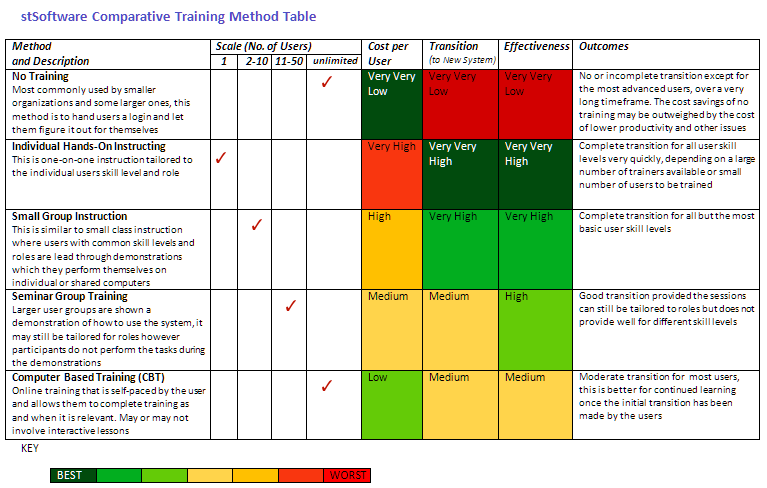The Developer provides training support for its systems.
stSoftware offers training programs to suit all levels of users.
stSoftware offers a number of training programs based on our RoBUST model which is a Roles Based User Training method, to achieve higher learning levels of functionality that is highly relevant to individual users and user groups.
It is important to plan user training which is relevant to all users, can be reproduced with new staff and be scalable so it can accommodate organisational change.
User Training Strategy
The training strategy adopted will be influenced by the number of users, the complexity of the system, the technical skills of users, the time frame to implementation and the budget that can be allocated to user training. These factors need to be determined before deciding on the final details of the strategy.
Number of Users:
With a small number of users any training method should be within budgetary restraints. When there are larger numbers of users the costs of different methods need to be considered. Often an approach where a combination of methods is used can bring the best outcomes in terms of costs, time frames and skills upgrades.
System and user technical skill levels:
As with all systems the proposed CMS solution has screens, tools and functions which individually are relatively simple for users to understand and use however as a whole can present initially as a complex new user environment. The higher the technical skill levels and general IT competencies of the user the easier this transition will be for them. The training method(s) used need to be mindful of any big differences between users skill levels so that higher level users do not feel their time is being wasted or lower level users are not overwhelmed by a fast moving training session.
Training Time frames:
The aim of user training is to as quickly as possible get users up to the skill level required to do their jobs using the new system and help them do their jobs more easily, quickly, accurately and securely than they could before. Adequate time allocation for training reduces user resistance to new systems and the downtime associated with final implementation.
Training Budget:
The training budget depends on the method used and the number of users. There are many training methods we can implement to bridge the knowledge gap for users some of which are outlined in the Comparative Training Methods Table.
Training Method:
At stSoftware we believe regardless of the training method(s) used we will achieve the best outcomes when they are modelled on Role Based User Training or RoBUST. This is effectively dividing the users into groups for system training which is focused on the performance of roles using the new system. The criteria formulating the groups will be; roles, technical skill levels and key users such as System Administrators and Managers.

Training Outcomes
The outcomes the training strategy aims to achieve which will be measured by assessment of user performance and feedback from users. Please consider the outcomes you want to achieve from training at this planning stage.
Some outcomes have been suggested below;
-
All users are able to access and use the system to complete tasks appropriate to their role efficiently and without assistance
-
All users have access to ongoing learning to enhance their user skills to better perform their roles
Further User Assistance
The new system will have an online Knowledge Base to assist all users with queries about database functionality. The aim of the Help and User Guide is to create a detailed, accessible, knowledge base for ongoing learning and user assistance that is cost effective and accessible to all users at all times and can be updated.